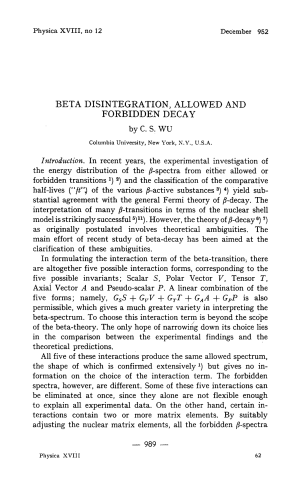BETA DISINTEGRATION, ALLOWED AND FORBIDDEN DECAY

In recent years, the experimental investigation of the energy distribution of the β-spectra from either allowed or forbidden transitions and the classification of the comparative half-lives of the various β-active substances yield substantial agreement with the general Fermi theory of β-decay. The interpretation of many β-transitions in terms of the nuclear shell model is strikingly successful. However, the theory of β-decay as originally postulated involves theoretical ambiguities. The main effort of recent study of beta-decay has been aimed at the clarification of these ambiguities.
There is another approach to this problem of determining the interaction form. That is, to investigate the angular correlation between the electron and the neutrino. Even in an allowed transition it is markedly different for .the different possible interactions. This is in contrast with the energy spectrum of the allowed transitions, which is the same for all types of interaction. According to the theoretical calculations 4o) the correlation functions between the electron and the neutrino of an allowed transition are given by S 1--v/ccos0 V l+v/ccosO T 1 +1⁄2v/ccosO A 1--~v/ccosO P 1--v/ccosO Although theoretically this approach should give more convincing results because of the predicted marked differences in the recoil of the neutrino, the experiments carried out so far on the recoil of the neutrino are not sufficiently accurate to draw any reliable conclusions.
,To avoid the complications of the surface effect on .the recoil ions, one naturally resorts to gaseous emitters. The most suitable gaseous emitter to use is 6He. 6He emits a negative electron with maximum energy of 3.5 MeV. James Allen recently investigated the distribution of the recoil 6Li ions from the decay of 6He. His best agreement is with 1--v/3c cos 0 as predicted for axial vector interactions. However the latest results on the 6He recoil experiment * by using well-defined 6He source is strongly in favor of the tensor interaction. Supplementary experiments are being carried out to check any possible scattering effects.
* Ruby, S. and Rustad, B. Private communication (Columbia Univ. or Brookhaven Nat. Lab.)